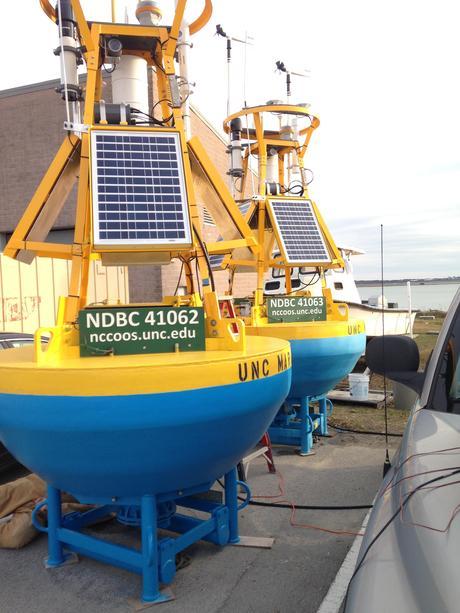The University of North Carolina at Chapel Hill will deploy two large buoys 20 miles offshore of the coast and 40 miles north and southwest from Cape Hatteras to capture wind, temperature and barometric pressure data for ongoing offshore wind energy research.

Buoys deployed by the UNC marine sciences department will capture wind, temperature and barometric pressure data for ongoing research on offshore wind energy. (Credit: UNC Chapel Hill)
The data will also be made available to the public—information that is important for local and commercial mariners, divers, weathermen and scientists.
In 2008, the North Carolina General Assembly asked UNC to assess the feasibility of wind energy off the N.C. coast. Harvey Seim, professor and chair of the department of marine sciences in UNC’s College of Arts and Sciences, led the wind resource assessment part of that study, in part to help identify viable lease block locations for offshore wind farms. The full report was published in 2009.
The two buoys, which will be deployed in late March to early April, will provide real-time data that will be transmitted via satellite to the National Weather Service and the National Data Buoy Center, both divisions of the National Oceanic and Atmospheric Administration (NOAA). The data will be used by global and national weather models thru NOAA and made available at http://www.ndbc.noaa.gov.
Located about 80 miles apart (one north of Cape Hatteras off Oregon Inlet, the other southwest of Cape Hatteras off Ocracoke Island), weighing 2,200 pounds and reaching 12 feet above the water, the buoys will be moored for about a year. These locations were identified to fill gaps in the historical wind data record and provide additional verification for the modeling effort. Cameras attached to the buoys will take still images of weather conditions hourly during the daytime.
The Institute of Marine Sciences in Morehead City, an off-campus research and education center of UNC-Chapel Hill, provided help with outfitting the buoys. YSI Integrated Systems and Services installed the electronics for the buoy instrumentation. Sara Haines, research associate in Seim’s lab, will manage the buoy data and will oversee the deployment efforts. The UNC Coastal Studies Institute (UNC-CSI), an inter-university research institute located on Roanoke Island, is partnering with marine sciences on the deployment and maintenance operations.
“The information from the buoys will fill a critical gap in our knowledge of the wind field offshore of North Carolina and will also provide real-time information on conditions in a very busy and dynamic area of the coastal ocean,” Seim said. “We’re excited to learn more about how the atmosphere and ocean interact off the North Carolina coast to produce such persistent winds.”

